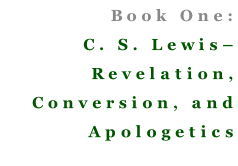

Revelation
The Christ




Outline
Contents
C. S. Lewis - Revelation, Conversion and Apologetics
Part One
The Personal God of Salvation - Conversion and Acceptance
Chapter 1 Conversion: God is God
Chapter 2 Acceptance: God is God, in Christ
Chapter 3 Helen Joy Davidman: Intellect and Imagination
Chapter 4 C. S. Lewis and Karl Barth I:
Religious Experience - Revelation and Modernity
Chapter 5 C. S. Lewis and Karl Barth II:
A Doctrinal Realisation - God is God, in Christ
Part Two
C. S. Lewis - Theologian and ‘Mere’ Christian
Chapter 6. C. S. Lewis the Classical Philosopher Theologian I:
Witness and Method - 'Mere' Christianity
Chapter 7. C. S. Lewis the Classical Philosopher Theologian II:
praeparatio evangelica - A Catholic-Evangelical
Chapter 8. C. S. Lewis the Classical Philosopher Theologian III:
Orthodoxy and Heresy - The Pittenger-Lewis Debate
Part Three
C. S. Lewis - Apologist, Broadcaster and Public Figure
Chapter 9. Apologist and Defender of the Faith I:
Revelation and Christology, 1931-1944 - The Early Works
Chapter 10. Apologist and Defender of the Faith II:
Revelation and Christology, 1941-1947 - The Middle Works
Chapter 11. Apologist and Defender of the Faith III:
Revelation and Christology, 1948-1963: The Later Works - Mere Christology
Chapter 12. Apologist and Defender of the Faith IV:
Revelation and Christology, 1948-1963: The Later Works - Christlikeness
Each chapter is subdivided into multiple sections
and sub-sections. Click here for a detailed contents :


This is the first book in the series. This book consists of three parts, twelve chapters in all; each chapter opens with a synopsis (of between 200 and 500 words) of the content and argument contained therein. Some chapters are quite long, but nonetheless are a coherent thematic whole despite their length. All chapters are divided into multiple sections and sub-sections to allow for ease of access to the material contained in these long chapters.
C.S. Lewis: Revelation and the Christ, Book One
C. S. Lewis – Revelation, Conversion, and Apologetics
Part One, The Personal God of Salvation – Conversion and Acceptance
Part One (chapters one to five) is about Lewis’s relationship with and acceptance of Christ; therefore we examine Lewis’s protracted conversion. Lewis became a Christian as a boy, but fell away from an active faith to become an apostate self-confessed atheist as a young man. As a young Oxford don he started to become religious – first an Hegelian, then a Deist; but then Christ revealed to him the reality of life, and he became a Christian. What was Lewis’s conversion from and to?
Lewis learned from George MacDonald, the Scottish author, poet, and Christian minister, the critical value of a baptized imagination, which was crucial in his conversion and his vocation as a Christian apologist. We can examine the conversion to Christ of Joy Davidman who later in life was to marry Lewis the confirmed bachelor and Christian apologist: how similar/dissimilar are they?
Lewis can be compared with other people who underwent a similar conversion. Lewis’s conversion can be elucidated by comparison with the conversion of the Swiss Reformed theologian Karl Barth: both arrive at a point where they must own that God is God (Barth 1915; Lewis 1929), which leads both of them to point to the unique self-revelation of God in Jesus, the Christ (Lewis is more the Romantic whereas Barth believes he must still measure all against Kant). In their mature work both are muscular, intellectual Christians who despite their denominational differences are orthodox-traditional, biblical-creedal Christians who argue against the zeitgeist of an enlightenment spawned modernism. However there are significant differences – particularly related to religious experience. Therefore how do the two conversions compare? And what does this tell us about Lewis’s relationship with Jesus Christ?
Part Two, C.S. Lewis – Theologian and “Mere” Christian
Part Two (six to eight) examines what was the basis or ground of Lewis’s work as a theologian, and apologist – what was his method, and what did he mean by “Mere Christianity”? The sources for this method came from a fifth-century Catholic monk by the name of Vincentius of Lérins (“What has been held Always, Everywhere, by Everybody”), and a seventeenth-century Puritan called Richard Baxter (“I am a Christian, a Mere Christian”). Therefore Lewis sought to promote a basic core, a sheer, undiluted, essence that was at the heart of the faith endorsed by scripture, and by this developed Patristic Church tradition. Lewis distrusted anything “modern” as compared to the Patristic foundations of theology. We can consider what it meant for Lewis to declare that he was a Catholic Evangelical, but also why so many professional churchmen and theologians claim he is not one of them, that he was an amateur.
What picture of Christ do we read from Lewis’s numerous theological writings as praeparatio evangelica (his phrase – for he saw himself as preparing his readers for the gospel, not necessarily converting them)? How did Lewis see his role – public and private – in bearing witness to Christ? How did he react against the modern world, for Christ’s sake? In 1958 the theologian, apologist and Process Theologian, W. Norman Pittenger publicly accused Lewis of Christological heresy. Lewis, however, refutes the accusation and then proceeded to demolish Pittenger’s Christology as dangerously “liberal.” Their differences come down to ontology and status: is Jesus Christ defined by the very nature of his being in and before God, or is he who he is because of humanely conferred status?
Part Three, C.S. Lewis – Apologist, Broadcaster and Public Figure.
Part Three (chapters nine to twelve) considers what picture of Christ we can read from Lewis’s numerous theological writings. What is the nature of the Christology, along with the understanding of revelation and salvation, in Lewis’s apologetics published after his conversion? We can give particular attention to his role as a public figure and apologist, and his attempt to present an interdenominational basic core of the content of the faith relating to the Christ (in particular his work at the BBC).
Lewis’s understanding of revelation relates closely to his doctrine of God, and is both orthodox and original in identifying areas of study which return the faith to orthodoxy whilst opening up human religiosity to the Christ event. Lewis considers theodicy and human pain, how we approach God’s justification in relation to affliction (The Problem of Pain). This is seen to be rooted in the person and the office of Jesus Christ. Although written to be broadcast to the general public The Broadcast Talks provide the strongest insight into Lewis’s technique as an apologist grounded in reductio ad absurdum, and into his Christology and doctrine of revelation. How does the incarnation, “The Grand Miracle” relate to God’s supra-natural action within this world? In the infinitum capax finiti (the infinite capable of the finite) revelation defines what our understanding of God’s infinity should be – the truly infinite capacity of God is also to be finite, specific, incarnated. This contradicts our religious expectations for a distant singular “god,” an unknowable and unattainable “god,” whereas transposition reveals the incarnation.
We can then consider what picture of Christ we can read from Lewis’s numerous mature theological writings, and how they are considered different to his popular apologetics from the 1940s, when he was at the height of his skill as an apologist and defender of the faith. Is Lewis’s Mere Christianity broadly creedal, orthodox. The answer is yes, but there are short comings. Some criticize it for a lack of emphasis on the Cross, however, it can be demonstrated that Lewis’s understanding of the Cross appears to be focused on the nature of atonement that issues from the death of Jesus of Nazareth, the Christ, and how this repays the debt generated by humanity through sin. Does this marginalise the place of punishment? Or is punishment subservient to the debt repaid through the Christ’s life blood spilt? It is the blood of the lamb, Jesus the Messiah, slain for our salvation, that is the key to Lewis’s understanding of the Cross, not necessarily the means (crucifixion) of his death; this is confirmed by the Hebrew categories defining the relationship between blood and atonement. This is clear from Lewis’s writings – particularly in The Chronicles of Narnia.
Towards the end of his life Lewis became more and more preoccupied in his writings with what may be termed Christlikeness: how Christ is translated into ordinary mortal humans. These people are not Christ, but exhibit some of the characteristics, such as the ability to sustain altruistic love, self-sacrifice, a graceful acceptance of a God-given reality, and so forth (for example, Till We Have Faces, Reflections on the Psalms, and both positively and negatively in The Chronicles of Narnia), where this is more than simply a comparison but is caused by the indwelling of the Holy Spirit. In his mature work Lewis points to the primacy of the Christ event, consistently.
PDF:

Download this essay in PDF:
PDF :: C.S. Lewis–Revelation Conversion and Apologetics
If citing this essay please use the following:
P.H. Brazier, ‘C.S. Lewis–Revelation Conversion and Apologetics’ www.cslewisandthechrist.net/csl_revelation_conversion_&_apologetics.html.
and then give paragraph numbers and date accessed.

Home
Book One
Book Two
Book Three
Book Four
Links
Contact
“In the Highest Degree”







Author


